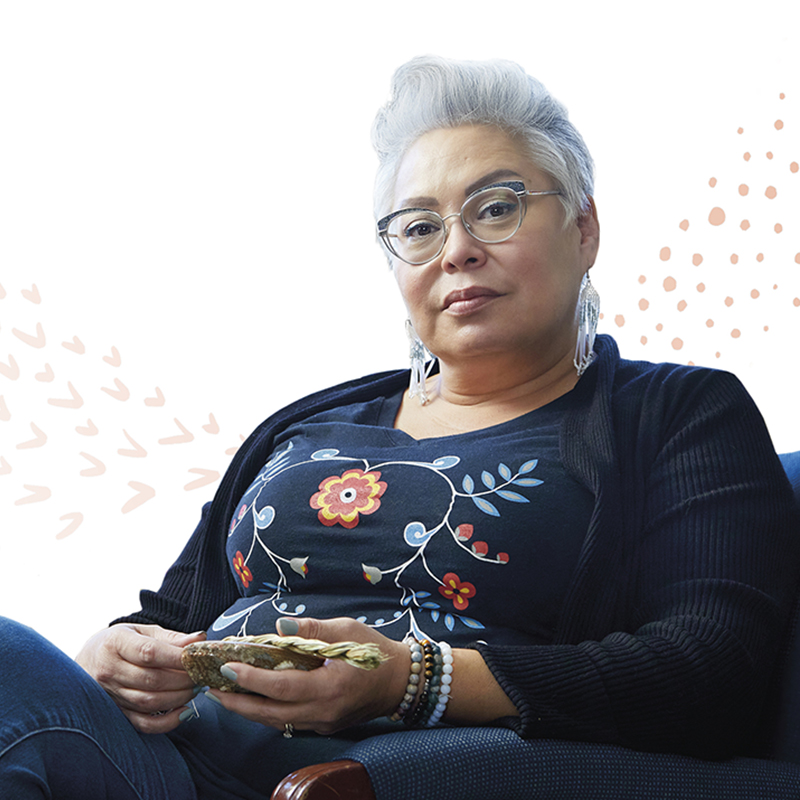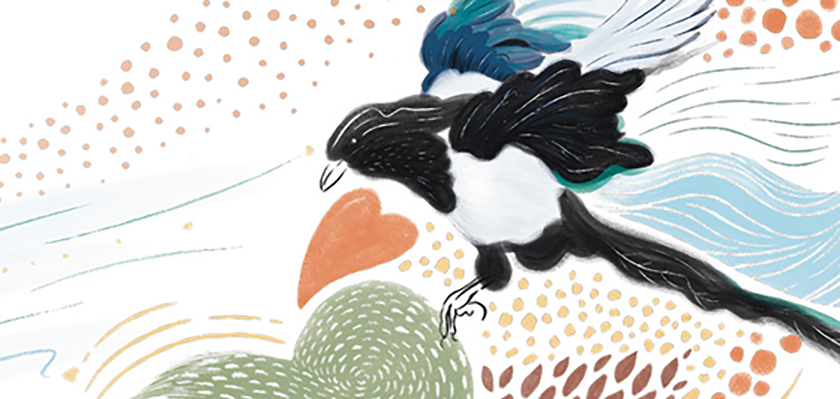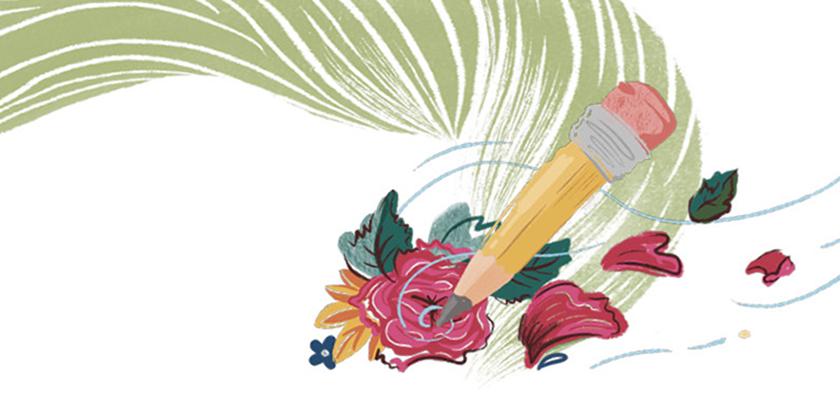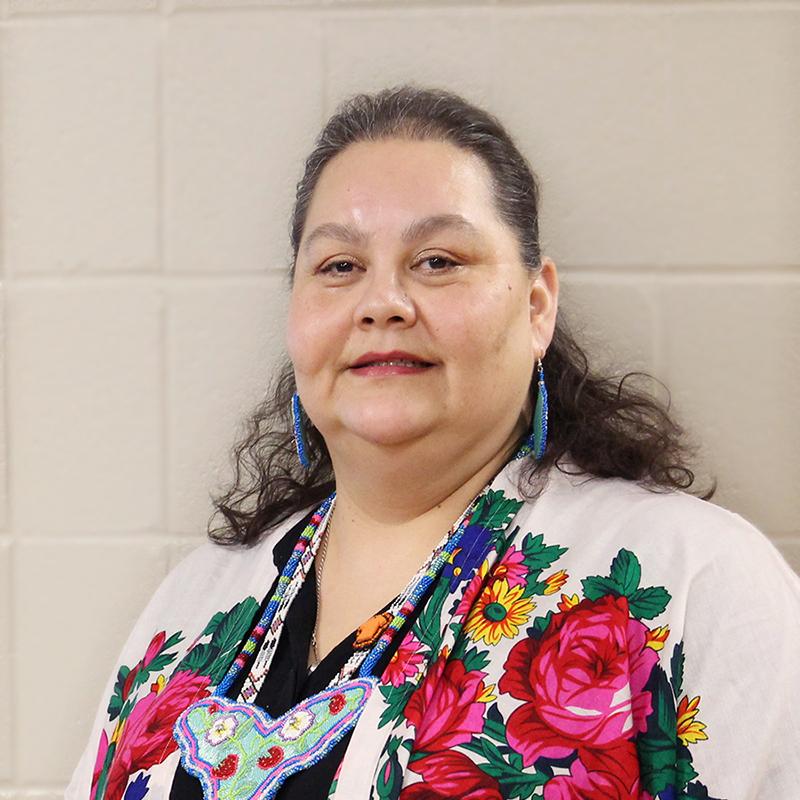Of all the magpies I’ve known, “Kathy” is my favourite. We formed a friendship through the early days of the Covid-19 pandemic, when the tree-sheltered balcony of my inner-city home became my temporary office.
Through the warm season, my husband and I began each day by filling the birdbath and watering the planters in our building’s courtyard, one storey below. We’d leave offerings for birds and squirrels and watch with delight as the magpies would swoop in to see what they might find. Over time they got bolder. Perched in the tree, they would call through our screen door urging us to our morning routine. One of them—Kathy, the “chattiest”—took particular interest in us.
When one of us stepped out onto the balcony, Kathy would sail in. Sometimes she’d bring us a song or an offering of her own—the metal ring tab of a pop can, a smooth pebble, or, in one instance, three small red berries that she delicately placed on the balcony railing.
Kathy became comfortable enough to hop along the balcony floor, chasing grapes or pausing to peck at my bare toes as I worked. One afternoon I was immersed in a task with a pressing deadline as Kathy perched in the branches above. After several failed attempts to call my attention, she became impatient. Dropping from the tree, Kathy landed on the edge of my laptop screen, which slid slowly closed under her weight as she flapped her wings and squawked a clear message: Human, it’s time to take a break.
In reminiscing about Kathy, I can’t help but remember the day that magpies first caught my attention. Professionally, it was the darkest season that I’ve faced. Feeling isolated and hopeless, I struggled to find the motivation to get out the door each day.
One morning I tried to lift my spirits by driving my favourite route to work, a winding road through a quiet, forested oasis that usually invites me to reflection. On this day, such inspiration eluded me.
Suddenly, from the trees ahead, a flash of black and white darted out. A magpie glided straight toward me. I slowed down to let it cross my path and the bird swept low over my car’s hood, then rose into the trees on the other side of the road.
I continued. Then another magpie sailed out—from the other side this time. Again, I slowed my vehicle. Again, the magpie sailed low, passing over the hood of my car. As I wound through the last stretch of the forested street, two more magpies completed this dance with my car. Four magpies. Four, a sacred number that, for the Blackfoot, represents balance, wholeness.
My discouragement forgotten, I wondered about these winged beings who had just brought me a timely message of hope. I’d driven this path countless times, and the magpies had never behaved this way. Why today of all days?
The greatest teacher
Looking back at all the time I’ve spent with mamiá’tsikimi: the magpie, I can see that they’ve been the greatest teacher. They’ve helped give me hope and helped me to flourish.
Through my 15-year career as an Indigenous educator, I’ve encountered many occasions when I’ve been overwhelmed by the investment required to implement change to help Indigenous students (and teachers) thrive. I’ve been discouraged by the complexities of navigating systemic racism and powerless to respond to big needs nested in holes too deep for me (or my colleagues or school leaders) to fill alone.
Teaching about the events that have traumatized Indigenous people—while being Indigenous—and the resistance that we often confront in the truth-telling, triggers my own trauma. It can be taxing to take up this work day after day with little systemic evidence of progress. Until pedagogical practices include the holistic, land-based connection and heritage languages that Indigenous students need, and they are given time to shape the relational culture of our school communities, we won’t see the growth that needs to happen.
My work presents an ongoing and sometimes overwhelming challenge, but through spending time with magpies, I’ve begun to see and approach it differently. Magpies are watchful, caring and generous. They practice reciprocity with gifts, but the gift-giving doesn’t just happen. It takes time, patience and reliability. It requires learning to be present without demands or personal agendas. It means coming to know what the magpies like and leaving offerings that they enjoy. It takes moving on their time.
Magpies crave connection. It’s the first thing they do each day: check in with others. When the magpies trust you, they will share space in silence. When inspired, they’ll share their throaty sing-songs with you. If you’re lucky, they’ll tell you a story.
Magpies will make you laugh. They’ll remind you that black and white (light and darkness, hope and discouragement) co-exist, and that sometimes all it takes to change perceptions is gaining another perspective.
I keep a “blessing box” to store a collection of the gifts that the magpies have left over the years. It contains a variety of small stones, twigs (to build my nest, I presume), the odd feather with flashes of blue, emerald, flecks of gold. There’s Kathy’s three shriveled berries, and a replica arrowhead.
These mementos the magpies leave remind me of the magic of our exchanges, of the experiences and the lessons.
I’m learning to dwell within those stories when I feel myself lingering too long with discouragement. Those magpies, they don’t stay in one place for long. Neither should I.

Piikani and western European Indigenous Education, Calgary Board of Education
Read more
View the entire digital issue of the ATA Magazine
See the latest issue


